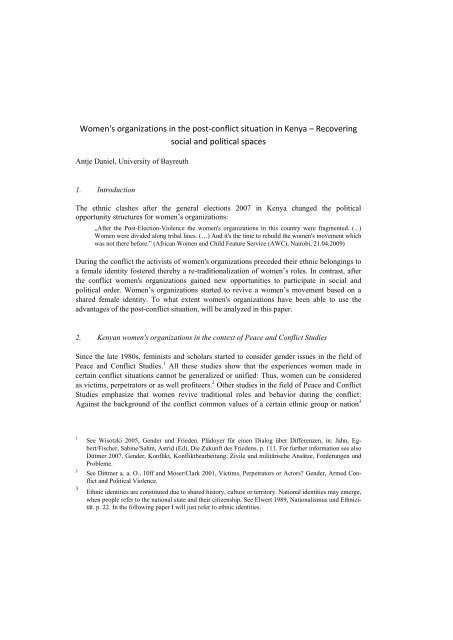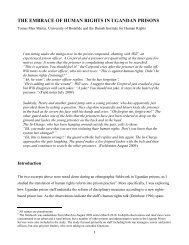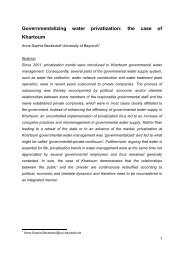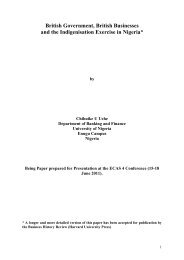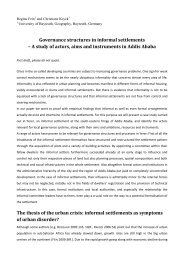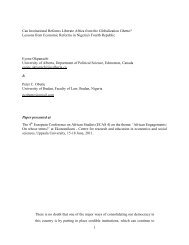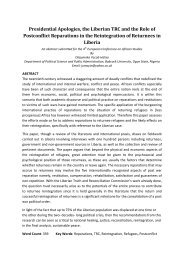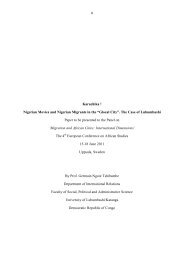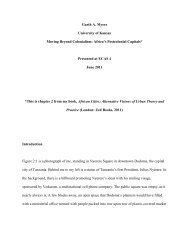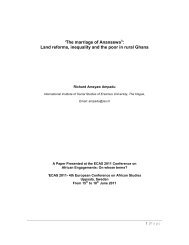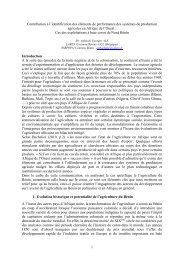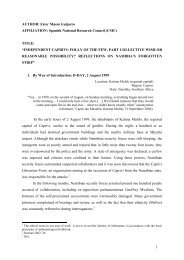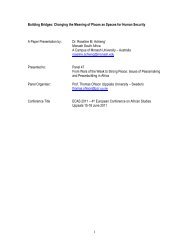Antje Daniel - Full paper - The Nordic Africa Institute
Antje Daniel - Full paper - The Nordic Africa Institute
Antje Daniel - Full paper - The Nordic Africa Institute
You also want an ePaper? Increase the reach of your titles
YUMPU automatically turns print PDFs into web optimized ePapers that Google loves.
Women's organizations in the post-conflict situation in Kenya – Recovering<br />
social and political spaces<br />
<strong>Antje</strong> <strong>Daniel</strong>, University of Bayreuth<br />
1. Introduction<br />
<strong>The</strong> ethnic clashes after the general elections 2007 in Kenya changed the political<br />
opportunity structures for women’s organizations:<br />
„After the Post-Election-Violence the women's organizations in this country were fragmented. (...)<br />
Women were divided along tribal lines. (…) And it's the time to rebuild the women's movement which<br />
was not there before.” (<strong>Africa</strong>n Women and Child Feature Service (AWC), Nairobi, 21.04.2009)<br />
During the conflict the activists of women's organizations preceded their ethnic belongings to<br />
a female identity fostered thereby a re-traditionalization of women’s roles. In contrast, after<br />
the conflict women's organizations gained new opportunities to participate in social and<br />
political order. Women’s organizations started to revive a women’s movement based on a<br />
shared female identity. To what extent women's organizations have been able to use the<br />
advantages of the post-conflict situation, will be analyzed in this <strong>paper</strong>.<br />
2. Kenyan women's organizations in the context of Peace and Conflict Studies<br />
Since the late 1980s, feminists and scholars started to consider gender issues in the field of<br />
Peace and Conflict Studies. 1 All these studies show that the experiences women made in<br />
certain conflict situations cannot be generalized or unified: Thus, women can be considered<br />
as victims, perpetrators or as well profiteers. 2 Other studies in the field of Peace and Conflict<br />
Studies emphasize that women revive traditional roles and behavior during the conflict:<br />
Against the background of the conflict common values of a certain ethnic group or nation 3<br />
1<br />
See Wisotzki 2005, Gender und Frieden. Plädoyer für einen Dialog über Differenzen, in: Jahn, Egbert/Fischer,<br />
Sabine/Sahm, Astrid (Ed), Die Zukunft des Friedens, p. 111. For further information see also<br />
Dittmer 2007, Gender, Konflikt, Konfliktbearbeitung. Zivile und militärische Ansätze, Forderungen und<br />
Probleme.<br />
2<br />
See Dittmer a. a. O., 10ff and Moser/Clark 2001, Victims, Perpetrators or Actors? Gender, Armed Conflict<br />
and Political Violence.<br />
3<br />
Ethnic identities are constituted due to shared history, culture or territory. National identities may emerge,<br />
when people refer to the national state and their citizenship. See Elwert 1989, Nationalismus und Ethnizität.<br />
p. 22. In the following <strong>paper</strong> I will just refer to ethnic identities.
overlap female identities and differences are getting negated in order to strengthen the<br />
cohesion of the group. Consequently, a re-traditionalization of gender identities starts: 4<br />
women are seen as mothers and as guardians of society or an ethnic group, whereas men are<br />
considered to be manly war heroes. 5 Consequently, identity constructions harden in conflict<br />
situations and inhibit multiple identity attributions 6 . Further approaches also see a<br />
continuation of re-traditionalization of gender roles in the post-conflict situation: With the<br />
aim to provide order and security, people revive pretended established values and identities.<br />
Thus, traditional images of man- and womanhood get revitalized. To what extent new spaces<br />
of action for women emerge in a post-conflict situation is not considered sufficiently. 7<br />
<strong>The</strong> analysis of women and women's organizations during the conflict situation in Kenya ties<br />
up to these approaches. During the conflict women became victims of sexual violence, as<br />
well as women's organizations became affected by the escalation of violence. On the other<br />
hand, women take part in the re-traditionalization of female identities by prefixing the<br />
affiliation of an ethnic group to an overall identity as women. In general, ethnic and female<br />
identities are not seen as contradictory poles in Kenya. Ethnic belonging is connected with<br />
traditional role models, whereas female identity usually will be affiliated with international<br />
standards on women's rights. Nevertheless, the transitions between the constructions of identity<br />
are fluent in the Kenyan context: Some women's organizations oppose international<br />
women's rights standards, as they are less connected to their environment and include traditional<br />
images of women in the construction of female identity. Nevertheless, it can be assumed<br />
that traditional role models tend to be revived in a conflict phase, while female identities<br />
fade into the background. <strong>The</strong> situation of women's organizations in post-conflict situation<br />
in Kenya differs from the usual considerations in the field of Peace and Conflict Studies.<br />
This situation is less connected with re-traditionalization of women’s roles but is attended by<br />
an opening of social and political areas of action. <strong>The</strong>reby, a female identity became again<br />
more and more important. To what extant women’s organizations used the possibilities of the<br />
post-conflict-situation is the main focus of the <strong>paper</strong>.<br />
4<br />
Gender refers to social constructed gender roles in contrast to sex, the physical and biological features of<br />
men and women. Gender-identities refer to values and roles of women and men. See Seifert 2004 a. a. O.,<br />
p. 15ff. In the following <strong>paper</strong> I will just refer to female identities.<br />
5<br />
See Engels/Chojnacki 2007, Krieg, Identität und die Konstruktion von Geschlecht, p.3 or Seifert a. a. O.,<br />
p. 113f.<br />
6<br />
See Joos 2004, Geschlechterverhältnisse in Kriegen und gewalttätigen Konflikten, in: Beiträge zur feministischen<br />
<strong>The</strong>orie und Praxis, p. 93.<br />
7<br />
See Kumar a. a. O., p. 23 and Moser/Clark a. a. O., p. 3, 13.<br />
2
In the following I will analyze women's organizations in the post-conflict-situation in the<br />
context of Social Movement Research: I am going to highlight the various aspects of the construction<br />
of a women's movement 8 , particularly in connection to the Political Opportunity<br />
Structures-, the Resource Mobilization-, the Collective Identity- and the Framing-Approach. 9<br />
This is – with regard to Kenyan women's organizations – insofar relevant, as in historic<br />
retrospect tendencies, it become visible for the first time, indicating the emergence of a<br />
women's movement based on a shared female identity. This <strong>paper</strong> therefore combines Peace<br />
and Conflict Studies with Social Movement <strong>The</strong>ory. Against this background, the empirical<br />
data which was collected in a three-month qualitative research in Kenya was interpreted.<br />
Guided Interviews, informal conservations and participant observation with representatives<br />
of women's organizations are the basis for the qualitative analysis, which is complemented by<br />
a literature review.<br />
8 According to Rucht social movements are collective actors including individuals, groups or organizations.<br />
Further social movements based on a shared identity and attempt to achieve or prevent social change, predominantly<br />
by means of collective protest See Rucht 1994, Modernisierung und neue soziale Bewegungen,<br />
p. 76f. Following this definition women’s movements are social actors who attempt to achieve gender<br />
equality<br />
9 Different approaches on social movements have been developed, but the focus of these concepts lies either<br />
on the emergence of social movements or in the way how mobilization and protest is organised. <strong>The</strong>re is<br />
no concept which integrates these different aspects (Hellmann 1998): Der Political Opportunity Structures-Approach<br />
plays attention to the political and institutional environment in which social movements<br />
operate. Thus it is argued the opportunity to protest is influenced by the openness of the political system.<br />
See Kitschelt 1999, Politische Gelegenheitsstrukturen in <strong>The</strong>orien sozialer Bewegungen heute, in:<br />
Klein/Legrand/Leif (Ed.), Neue soziale Bewegungen. <strong>The</strong> Approach of Resource Mobilization reflects<br />
how social protest can be mobilized and emphasizes that organizational abilities - like the structures of the<br />
social movement or the integration in networks are important for mobilizing social actors. Additional resources<br />
- like material resources and non material resources have an impact on mobilizing social protest.<br />
See MacCarthy/Zald 2001, <strong>The</strong> Enduring Vitality of the Resource Mobilization <strong>The</strong>ory of Social Movements,<br />
in: Turner (Ed.), Handbook of Sociological <strong>The</strong>ory. <strong>The</strong> Collective Identity- Approach emphasizes<br />
the importance to build-up collective identity for social movements. Scholars argue that the readiness to<br />
protest revives only over the development of a collective identity. See Taylor/Whittier 1992, Collective<br />
Identity in Social Movement Communities, in: Morris/Mueller (Ed.), Frontiers in Social Movement<br />
<strong>The</strong>ory. <strong>The</strong> Framing-Approach explores how social movements interpret a social problem and the procedures<br />
from the point of definition to the mobilization of social protest. According to this understanding social<br />
movements define a social problem and inform the public about it. <strong>The</strong>se way social movements can<br />
influence the public opinion, mobilize actors and legitimate their protest. See<br />
Snow/Rochford/Worden/Benford 1986, Frame Alignment Process, Micromobilization and Movement Participation,<br />
in: American Sociological Review.
3. Women and women's organizations during the 2007/08 conflict<br />
<strong>The</strong> escalation of violence following the presidential elections on the 27/12/2007 had an influence<br />
on the self-definition and organization of women in Kenya, as due to the outbreak of<br />
violence, the areas of action for women and women's organizations changed.<br />
<strong>The</strong> escalation of violence following the presidential elections and the peace agreement<br />
<strong>The</strong> elections sparked a wave of violence between the opposition of Raila Odinga (Orange<br />
Democratic Movement - ODM) and the government of President Mwai Kibaki (Party of National<br />
Unity - PNU). On the 30/12/2007 the Electoral Commission of Kenya announced that<br />
Kibaki had won - with 4.58 million votes - against Odinga - with 4.35 million - and Kalanzo<br />
Musyoka (ODM-Kenya) - with 0.88 million votes. 10 Independent election observers criticized<br />
irregularities in the election on both sides and assumed a narrow victory for Odinga.<br />
However the victory of the opposition leader could not be proven.<br />
<strong>The</strong> outbreak of violence is not just rooted in the ections, but is based on social, political and<br />
ethnic disparities as well as on the unequal access to land and to political and social positions<br />
of power, rising unemployment and increase in poverty rate. Political leaders<br />
instrumentalized these and linked them to ethnic belonging in order to gather local, regional<br />
and ethnic loyalties in the electoral process. 11 Thus, supporters of the opposition underlined<br />
the discrimination of their ethnic groups, such as the Luo, Luhya and Kalenjin, and criticized<br />
the ruling elite of the Kikuyu in order to be able to hold on to power, whatever it takes. 12 <strong>The</strong><br />
supporter of the ODM felt betrayed after the electoral victory and attacked pretended<br />
supporters of the PNU. <strong>The</strong>se attacked the ODM in the same way: “Violence against members<br />
of other ethnic groups after the elections in Kenya in 2007 is thus by no means spontaneous.<br />
Ethnic violence has been strategically fueled by different actors affiliated with the political<br />
parties and has even been disposed in some cases.” 13 During the conflict around 1133<br />
10 See Hanrneit-Sievers 2008, Kenia: Wahlen und die Eskalation von Gewalt, in: GIGA Fokus, p. 2.<br />
11 See Hanrneit-Sievers a. a. O., p. 4 and Taibl 2009, „Kikuyu problem“ und „Luo agenda“. Zur Politisierung<br />
von Ethnizität bei den Wahlen 2007, in: Stichproben p. 154f.<br />
12 See Shollei et al 2008, Waki Report. A Summary of the Report of the Commission of Inquiry into Post<br />
Election Violence, p. 4f.<br />
13 Shollei et al a. a. O., p. 159.<br />
4
people have died, 3561 people have been injured, 117,216 possessions have been destroyed<br />
and around 500,000 people have been displaced. 14<br />
<strong>The</strong> international community concerned about the conflict in Kenya, which resulted in the establishment<br />
of the Panel of Eminent <strong>Africa</strong>n Personalities, led by Kofi Annan. <strong>The</strong> aim of<br />
this group was to initiate a consensus between the conflicting parties. <strong>The</strong> efforts of the actors<br />
led to a power sharing between the two political opponents, which was agreed upon on<br />
27/02/2008: <strong>The</strong> presidential chair remained in Kibaki's hands, while Odinga was given the<br />
post of prime minister. In addition, the coalition partners promised to grant peace, to start a<br />
truth, justice and reconciliation process and to let the people vote on a draft constitution. 15<br />
Gender-based violence and ethnicity<br />
<strong>The</strong> escalation of violence following the presidential elections entailed a high degree of<br />
gender-based violence. Even before, the number of women affected by violence increased:<br />
During the year 2000 7930 cases of sexual violence were recorded and the number rose to<br />
11,867 in 2004. 16 In the course of the conflict (between December and February) 1171 cases<br />
of sexual violence have been registered in the hospitals. This included 80 percent of rapes,<br />
nine percent of physical assaults, seven percent of domestic violence and four percent of<br />
“immoral” attacks. 17 <strong>The</strong> estimated number of unreported sexual violence cases is suspected<br />
to be much higher, since - due to shame and social stigmatization – many victims don’t report<br />
any act of violence. <strong>The</strong> perpetrators of violence were both members of the conflicting ethnic<br />
groups and neighbors as well as police officers. 18 It is striking that the violence was accompanied<br />
by a considerable degree of cruelty and mass rapes.<br />
Further, the escalation of violence offered a platform for patriarchal voices arguing against<br />
women's rights activities, which resulted partly in violence against women's organizations.<br />
For example, the Federation on Women Lawyers (FIDA) in Kisumu became a victim of such<br />
violent attacks: conservative opponents - who rejected the women's rights activities and saw<br />
in it a threat to the existing family and societal structure - could attack FIDA and use ethnicbased<br />
arguments for this.<br />
14 KHRH 2008, Human Rights Report January-June 2008, p. 45.<br />
15 Kopsieker 2008, Die Rolle der externen Akteure bei der Bewältigung der Krise, in: Kurzberichte aus der<br />
Internationalen Entwicklungszusammenarbeit Afrika, p. 8.<br />
16 Ochich/Ekuru 2008, Human Rights Report, p. 8.<br />
17 CREAW 2008, Women paid the price. Sexual and gender-based violence in the 2007 post-election con-<br />
flict in Kenya, p. 5.<br />
18 See KHRH, a. a. O., p. 21.
Tensions between ethnic groups also constrained the work in and among the women's organizations:<br />
Employees prefixed their ethnic belonging to a female identity, leading to mistrust or<br />
even the split in women's organizations. At the same time, representatives of women's organizations<br />
reported how increasing mistrust of other ethnic groups paralyzed co-operations and<br />
networks.<br />
<strong>The</strong> ethnic mobilization preceding the elections and the following fragmentation of women's<br />
organizations along ethnic lines illustrates that identities became increasingly inflexible. In<br />
some cases multiple identities were not possible and ethnic belongings overlapped female<br />
identities. <strong>The</strong> history of women's organizations in Kenya shows that ethnic belongings between<br />
members of women's organizations aren’t new and were sometimes used to secure<br />
their own advantages. But, the particular situation of the conflict didn’t allow multiple identities,<br />
what resulted in the dominance of ethnic belongings over the identification as a woman.<br />
Consequently, gender-based violence was used as a strategic tool to weaken the assumed other<br />
ethnic group during the conflict. 19 This action is based on a traditional image of women,<br />
declaring women as guardians of the ethnic group: Violence against women therefore aims to<br />
destroy the reproductive capacity of a group and undermine its social cohesion. 20 At the same<br />
time, female identities were overshadowed by ethnic identities. Traditional roles were constructed,<br />
and thus women were pushed back into the private sphere. Thus, the public and political<br />
areas of action were closed for the self-organization of women, since the return to the<br />
traditional women's role functioned as an essential element for constructing ethnic belonging,<br />
which in turn preceded a female identity. Women and women's organizations therefore became<br />
victims of the conflict on the one hand; on the other hand women themselves were involved<br />
as actors in the re-activation of ethnic identities. <strong>The</strong>ir violent excesses in turn made<br />
women become victims.<br />
4. Historical lines of women's organizations in Kenya<br />
Various studies in the field of Peace and Conflict Studies illustrate how the end of a conflict<br />
is accompanied by a return to traditional roles of women. 21 Even for Kenya one would sug-<br />
19 See Engels/Chojnacki a. a. O., p. 7 or Seifert 1996, <strong>The</strong> Second Front. <strong>The</strong> Logic of Sexual Violence in<br />
Wars, in: Women’s Studies International, p. 39ff.<br />
20 See CREAW a. a. O., p. 15.<br />
21 See Meintjes/Pillay/Turshen a. a. O.<br />
6
gest that with a consolidation of ethnic belongings female identities are being pushed in the<br />
background. However, looking at identities of women - at the level of collective actors - it<br />
can be seen that the scope of action for women's organizations opened up after the ending of<br />
the conflict. <strong>The</strong>se possibilities were used by women's organizations to draw attention on<br />
gender disparities and to rebuild a gender sensitive post-conflict society. How women’s organizations<br />
used the possibilities gained in the post-conflict situation should be interpreted by<br />
considering the historical lines of women’s organizations.<br />
Since decolonization in 1963, the authoritarian rule of the “de-facto one-party state” under<br />
the Kenya <strong>Africa</strong>n National Union (KANU) suppressed and co-opted civil society actors and<br />
thus women's organizations, too. 22 <strong>The</strong> first independent women's organizations such as<br />
FIDA or the <strong>Africa</strong>n Women's Development and Communication Network, which also had a<br />
political orientation, emerged as a result of the World Conference on Women in Nairobi in<br />
1985. <strong>The</strong> World Conference on Women provided Kenyan women with a framework for action<br />
and legitimacy in order to organize themselves - despite the repressive regime. 23 From<br />
the beginning, these were supported by external donors. This was the first time that there was<br />
a possibility for civil society organizations to start independent programs and to speak out<br />
against the government critically. As the political space for civil society organizations opened<br />
up in the 1980s – due to a “de-legitimatization” of the regime, caused by a politic and economic<br />
crisis - a women's movement was formed and took part in the protests for the introduction<br />
of a multi-party system. 24<br />
Although KANU was reelected during the first multi-party elections in 1992 the civil society<br />
space expanded, which resulted in a bloom of other organizations. Even activists began to<br />
demand women's rights at the national level for the first time. <strong>The</strong> impact of women's organizations<br />
was low, as patriarchal society and a negative attitude of members of parliament towards<br />
the introduction of gender reforms conflicted with the realization of women's rights. At<br />
the same time there was a lack of common goals and collective activities amongst the actors.<br />
<strong>The</strong>refore, the commitment of women's organizations remained usually limited to individual<br />
activities and concentrated prior to elections. 25 In part, women's organizations were used for<br />
personal profile or for political lobbying. Another obstacle was the fact that women's organi-<br />
22<br />
See Kihiu 2010, Women as Agents of Democratisation. <strong>The</strong> Role of Women’s Organisations in Kenya, p.<br />
161f and Odoulu/Kabira 1994, <strong>The</strong> Mother of Warriors and her Daughters. <strong>The</strong> Women’s Movement in<br />
Keny, in: Basu (Ed.), Women’s Movements in Global Perspective.<br />
23<br />
See Wölte 2008, International – national – lokal. FrauenMenschenrechte und Frauenbewegung in Kenia,<br />
p. 134f.<br />
24<br />
See Odoulu/Kabira a. a. O., p. 194ff.<br />
25<br />
See Kihiu a. a. O., p. 106f and Nzomo 1998, Kenya: <strong>The</strong> Women’s Movement and Democratic Change,<br />
in: Villanón/Huxtable (Ed.), <strong>The</strong> <strong>Africa</strong>n State at a Critical Juncture. Between Disintegration and Reconfiguration,<br />
p. 173.
zations that operated nationally poorly integrated rural women's groups and thus only had a<br />
slight connection to grass-roots activists. This created a gap between nationally oriented<br />
women's organizations, which claimed to be representatives of all Kenyan women and rural<br />
women who felt little of the national commitment at the local level. 26<br />
In 2002 - with the victory of Mwai Kibaki of the National Rainbow Coalition (NARC) in the<br />
presidential election - 40 years of KANU rule ended, and external observers postulated a further<br />
democratization process. Establishing organization was facilitated and the relationship<br />
between women's organizations and the state changed. Gender issues were included in the<br />
policy formulation and forced towards a co-operation with the activists: “<strong>The</strong> opportunities<br />
presented by a reformist government after 2002 have made it easier for women's organizations<br />
to work in the political arena.” 27<br />
<strong>The</strong> fact that women's organizations only had minor success in overcoming gender inequalities<br />
is due to the low efficacy of the women's movement. <strong>The</strong> explanatory factors for the differentiated<br />
approaches of the Social Movement Research refer to conditions for collective action<br />
and can be used as an explanation. <strong>The</strong> political areas of action in Kenya expanded continuously,<br />
especially since overcoming the authoritarian domination. <strong>The</strong>se changes have<br />
contributed to the fact that women could organize autonomously. However, the activities of<br />
the organizations were inhibited by the patriarchal society and in particular conservative actors<br />
of the political system (Political Opportunity Structures-Approach). 28 <strong>The</strong> opening of political<br />
space has also helped to strengthen the agenda-setting of women's organizations. Further,<br />
the provision of resources from financial development aid is an important prerequisite<br />
for the activities of women's organizations. <strong>The</strong> commitment of women's organizations is<br />
mainly inhibited by low politicization and fragmentation among women's organizations (Resource<br />
Mobilization Approach). On the one hand, the low politicization of women's organizations<br />
inhibits the enforcement of interests against state institutions. <strong>The</strong> majority of women's<br />
organizations does not seek to change gender relations or to initiate a societal change in terms<br />
of gender disparities, but rather seeks to provide social services. On the other hand, fragmentation<br />
between women's organizations exists 29. <strong>The</strong>se regional or ethnic differences as well as<br />
the competition for external financial funding conflict with collective actions under the um-<br />
26 See Wölte, a. a. O., p. 160.<br />
27 Kihiu, a. a. O., p. 183.<br />
28 See Kihiu, a. a. O., p. 127.<br />
29 See Kihiu, a. a. O., p. 153 ad Schmidt 2000, Die Rolle der Zivilgesellschaft in afrikanischen Systemwechseln,<br />
in: Merkel (Ed.), Zivilgesellschaft und Transformation.<br />
8
ella of a shared female identity and thus weaken the formation of a women's movement<br />
(Collective Identity-Approach).<br />
5. Post-conflict situation: Recovering social and political spaces?<br />
<strong>The</strong> conflict paralyzed the women's organizations and almost brought their activities to an<br />
end. However, in the post-conflict situation, spaces for the self-organization of women have<br />
been created. With respect to historical lines of development, the current involvement of<br />
women's organizations is moving on a continuum between innovation and old features of<br />
self-organization. According to some explanatory factors from Social Movement Research I<br />
intend to highlight, to what extent the activities of women's organizations in post-conflict situation<br />
change and what resources they have (Resource Mobilization-Approach). I also examine<br />
the extent to which social and political spaces promote the activities of women's organizations<br />
(Political Opportunity Structures-Approach) and how they are used by activists<br />
through agenda-setting in public (Framing-Approach). With the formation of a women's<br />
movement in mind, I finally observe the collective cohesion of activities and networks (Collective<br />
Identity-Approach).<br />
Strengthening welfare activities and the commitment to reconciliation<br />
With the end of a conflict numerous women's organizations take care of victims of sexual violence.<br />
For example, the Coalition on Violence Against Women (COVAW) in Nairobi takes<br />
women affected by violence and assures them of medical care in hospitals. Other organizations,<br />
such as the Gender and Development Center in Kisumu, are active in the refugee<br />
camps themselves or support refugees in covering their basic needs. All these activities have<br />
been done for women, regardless of their ethnic origin. Women's organizations are also active<br />
in social reconciliation processes. For instance, the Women Action Forum for Networking<br />
(WAFNET) and the National Response Initiative promote national reconciliation by organizing<br />
multi-ethnic soccer games in Sotike and in Kisii and thus bringing previously conflicting<br />
ethnic groups together.<br />
Agenda-setting in the post-conflict situation<br />
In addition to the welfare commitment, women's organizations are also involved in building<br />
up a new social and political order. During the conflict itself and in the post-conflict situa-
tion, the media almost reports daily about gender-based violence. <strong>The</strong> report on human rights<br />
violations in the conflict situation (Waki Report) 30 also deals with the level of violence. <strong>The</strong><br />
wide coverage of sexual violence initiated a public debate on violence against women for the<br />
first time. 31 Women’s organizations use the media to draw attention on the violence against<br />
women and to break the existing stigma and taboo. <strong>The</strong> public discussion about violence<br />
against women allows women's organizations to locate it as a social problem and to legitimate<br />
the work of women's rights organizations. This results in a discursive process during the<br />
post-conflict situation, which enables a common concern of women beyond any ethnic belonging.<br />
Thus, images of women are going to become part of a general societal identity construction.<br />
In addition, the widely shared concern of sexual violence has many women shown<br />
the consequences of the conflict and have therefore strengthened the cohesion between them.<br />
Previous polarizations between female and ethnic identity are not specifically resolved completely,<br />
however, identity constructions become more flexible and fragile. It is often stressed<br />
by women's organizations that a multiple identities and the strengthening a female identity<br />
are main objectives of the post-conflict situation.<br />
Following the public agenda-setting many women's organizations also participate in relevant<br />
committees for dealing with human rights violations. In the process of reconciliation many<br />
civil society actors, including women's organizations are included. For dealing with human<br />
rights crimes, the government established the Truth, Justice and Reconciliation Commission<br />
(TJRC). FIDA and COVAW are involved in the civil society representation of the TJRC, the<br />
TJRC Task Force. <strong>The</strong> Task Force offers an important platform for incorporating gender issues<br />
into the processes of reconciliation. Women's organizations participate in societal<br />
processes, thus preserving a public forum and designing the processing of the post-conflict<br />
situation in a gender sensitive way.<br />
<strong>The</strong> involvement of women's organizations in the constitutional process can be considered as<br />
another success. <strong>The</strong> people voted for it on 4/8/2010 by a referendum. With regard to gender<br />
issues, the draft wants to ban all forms of gender-based discrimination, including violence<br />
against women, promotes abortion rights in case of a life threat to the mother, grants land<br />
rights and ownership to women or secures equal marriage rights and responsibilities to men<br />
and women. 32 Numerous campaigns of the women’s organizations followed the referendum.<br />
30 See Shollei et al, a. a. O., p. 2f.<br />
31 See Siebert, a. a. O.<br />
32 See AWC 2010, Women Gains in the Proposed Constitution of Kenya.<br />
10
Debates between activists and conservative opponents - supported for instance by the church<br />
- inflamed especially concerning the issue of abortion rights. 33<br />
<strong>The</strong> draft constitution was finally accepted, with 67 percent of the votes taken. 34 <strong>The</strong> change<br />
in the legal situation is seen as an achievement of the women’s rights commitment. “It cannot<br />
be doubted that the constitution has created a framework of law that responds in a very direct<br />
and unequivocal manner to the age-old discrimination against women in Kenya.” 35 Activists<br />
took part in the discussion on the constitution before and after the referendum. In February<br />
2011 for example, activists organize a petition against the nomination of public offices by the<br />
President. 36 <strong>The</strong> allocation of this post would contradict the gender parity, laid down in the<br />
constitution.<br />
<strong>The</strong>se examples illustrate that women's organizations use these opening areas of action for<br />
themselves. At the same time, the opportunity structures strengthen their civil society positioning.<br />
<strong>The</strong> organizations act as intermediaries between state and society and contribute to<br />
the formation of opinion in the social and political field. Women's organizations could thus<br />
strengthen their bargaining power against governmental institutions.<br />
<strong>The</strong> commitment of the international donor community<br />
<strong>The</strong> activities of women's organizations and their projects in the area of reconciliation and<br />
welfare programs were promoted by the international donor community. Development assistance<br />
funds are increasingly being awarded to projects in the field of conflict processing. This<br />
donor policy is understood as a response to the ethnically based conflict and wants to prevent<br />
discrimination and disparities by regional spreading and an ethnically sensitive allocation of<br />
funds.<br />
Also networks and cooperation projects are supported in order to strengthen the cohesion between<br />
the women’s organizations and to favor joint activities in a women's movement. However,<br />
the already existing dependence on external donors before the conflict continues to exist.<br />
This creates the risk that programs and networks post-conflict situation have more of a<br />
cosmetic nature in the, since women's organizations follow the guidelines of funders and are<br />
not necessarily based on the self-interest of actors. <strong>The</strong> focus shifted towards welfare activities<br />
has also lead to the fact, that welfare activities precede the politicization of gender issues.<br />
33<br />
See several articles of the Daily Nation among others 17.07.2010 and 05.08.2010.<br />
34<br />
See Daily Nation 04.08.2010.<br />
35<br />
Odhiambo/Oduor 2010, Gender Equality in the new Constitutional Dispensation of Kenya, p. 34.<br />
36<br />
<strong>The</strong>se are the position at attorney general, prosecutor and the Supreme Court and the financial director.
However, the public politicization is important in order to influence political decisions and in<br />
order to demand accountability of state institutions regarding the implementation of legal<br />
provision. Some networks that emerged in the post-conflict situation focus on the overall societal<br />
well-being of women and get involved for gender equality on the national level.<br />
Networking activities and movement building<br />
<strong>The</strong>re are two main networks of importance in the post-conflict situation: <strong>The</strong> Gender-Based<br />
Violence Sub Cluster (GBV-cluster) and a network called G10. <strong>The</strong> former was created by an<br />
initiative of the United Nations in the framework of the internationally applied cluster system<br />
of the Inter-Agency Standing Committees in January 2008. To coordinate the humanitarian<br />
assistance, to increase accountability and partnership between the funders, civil society organizations<br />
and government institutions the activities of all these actors are organized in networks<br />
– so-called clusters. 37 Whereas the majority of sub-clusters dissolve after the crisis in<br />
Kenya the GBV-cluster is continuing. Since October 2008 it is subordinated to the National<br />
Commission on Gender and Development and represents over 50 representatives of the<br />
government, the civil society and the donors. <strong>The</strong> GBV-cluster aims at informing about<br />
gender-based violence, coordinating the activities in this area, at developing tools together to<br />
combat violence against women and at persuading state institutions with regard to these<br />
issues. 38<br />
<strong>The</strong> meetings of the cluster, however, show that many relevant women's organizations participate<br />
only rarely and are mainly from Nairobi. Thus, the nationally-oriented cluster only partly<br />
meets the demands of being a national forum. Moreover, the discourse patterns refer to<br />
hierarchies between the actors. <strong>The</strong> discussion leaders include development aid funders, whereas<br />
the vast majority of activists remain reluctant. Hereby, the existing balance of power<br />
among women's organizations and their donors remains. Nevertheless, the cluster is a major<br />
public space for discourse and exchange between women's organizations.<br />
37 <strong>The</strong> cluster-system is organized in sub-cluster, which address health, economy, and agriculture and<br />
so on. Gender is a cross-secional issue. Access 25.10.2010<br />
http://.humanitarianreform.org/humanitarianreform/Default.aspx?tabid=53.<br />
38 See GBV Sub Cluster Strategy and Action Plan for Kenya 2008.<br />
12
<strong>The</strong> G10 Network was founded in February 2009 by more than ten women's organizations<br />
located in Nairobi. 39 Compared to the internationally initiated GBV-cluster initiative, this initiative<br />
is much more traced back to the Kenyan context. <strong>The</strong> participating organizations are<br />
working with different emphasis in the field of women's human rights in Nairobi and plead<br />
for gender equality by lobbying and advocacy on the national level. G10 particularly wants to<br />
strengthen the cooperation between women's organizations on the national level. <strong>The</strong> network<br />
enters public stage with the “sex boycott” in April 2009. This ten-day initiative calls on<br />
all Kenyans to follow this “sex boycott” to initiate a reflection on gender-based violence and<br />
to hold the government accountable. 40 Women are less rigid to follow the boycott, as the<br />
main reason is to demonstrate the possible effectiveness of women in familiar and social<br />
spheres. <strong>The</strong> boycott triggered a heated debate over sexuality, women's roles and the politicization<br />
of the private sphere. 41 Thus, the boycott isn’t only media wise successful, but also<br />
held the government accountable. A joint meeting between women's organizations and the<br />
government is organized in order to debate about women's rights.<br />
<strong>The</strong> “sex-boycott” shows that women's organizations position themselves politically successful<br />
and are perceived as relevant actors by the government. A closer examination of the network<br />
makes it clear, that G10 is composed of a selected group of prominent women's organizations<br />
and that the network so far hasn’t been able to concentrate diverse and regionally dispersed<br />
opinions of activists. <strong>The</strong>refore, the boycott has been rejected by many rural women's<br />
groups.<br />
Through networks during a post-conflict situation emerge, the cooperation between activists<br />
gets promoted in order to address ethnic fissures. Women's organizations are strengthened in<br />
their public and political impact and turn into relevant actors in the dialogue with government<br />
institutions. Indeed, the activists have reconfigured themselves during the post-conflict<br />
situation, but nevertheless a women's movement with common goals and identities cannot be<br />
identified. A variety of activities is carried out with the claim of national representativeness,<br />
but can be regarded as given by no means. <strong>The</strong>re still exist gaps between women's<br />
organizations along social or along regional and ethnic lines. Ethnicity still plays an<br />
important role in some women's organizations, but without perceiving the ethnic and female<br />
identities necessarily as oppositional. Disparities, for example between rural women's groups<br />
and women's organizations in Nairobi still exist, since the former feels little represented by<br />
women’s organizations in Nairobi and is not included in some of their activities.<br />
39 Some women’s organizations are FIDA, COVAW, AWC, Kenya Caucus for Women’s Leadership<br />
or the Young Women Leadership <strong>Institute</strong>.<br />
40 See Njogu/McHardy 2009, To be a Kenyan Women: A Look at Sexual and Gender-Based Violence,<br />
in: Concerned <strong>Africa</strong> Scholars Bulletin, p. 33.<br />
41 For further information see Daily Nation 29.09.2009.
One of those examples is the Gender Festival. 42 This festival, which was organized for the<br />
first time in July 2009 aims to overcome ethnic barriers and to strengthen the cohesion<br />
among the actors. Despite the explicit claim of being a national forum, mostly women's organizations<br />
from Nairobi are represented. An open space that reflects the variety of selforganized<br />
women cannot be identified. Many initiatives for the creation of a women's movement<br />
based on collective identity therefore emerge during the post-conflict situation, but existing<br />
hierarchies and mechanisms of exclusion are occasionally reproduced. It remains to be<br />
seen whether a women's movement is going to be formed on the basis of a common female<br />
identity. So far, it is clear that identity attributions in post-conflict situations are again negotiable<br />
and flexible and that female identities are added weight to, that wasn’t previously<br />
known.<br />
6. Conclusion<br />
<strong>The</strong> analysis of women's organizations in conflict and post-conflict situations in the context<br />
of Social Movement Research and in the field of Peace and Conflict Studies, offers the possibility<br />
of connecting previously separate discourses with each other and thus offering new<br />
perspectives for analysis. <strong>The</strong> Social Movement Research can provide several important<br />
starting points, particularly for the consideration of collective actors – in this case women's<br />
movement - therefore complements existing approaches and analyses of Peace and Conflict<br />
Studies.<br />
Relying on the analysis of Social Movement Research and the Peace and Conflict Studies<br />
Kenyan women's organizations in the conflict and the post-conflict situation have been analyzed:<br />
women and women's organizations became victims of sexual violence during the conflict<br />
in Kenya, as well as traditional images of women have been revived. Employees of<br />
women's organizations acted as agents of the conflict and also contributed to the fact that female<br />
identities were overshadowed by ethnicity. Whereas many analyses state a retraditionalizing<br />
of women’s roles during post-conflict phases, social and political areas of action<br />
opened up for Kenyan women's organizations. <strong>The</strong> relatively short duration of the conflict<br />
played an important role in ensuring that it can be seen as a catalyst instead of a consolidation<br />
of traditional women's roles. <strong>The</strong> conflict was a kind of turning point for civil society<br />
organizations, highlighting a possible scenario of ethnic conflicts and forcing women's organ-<br />
42 <strong>The</strong> Gender-festival is organized by 10 women’s organizations.<br />
14
izations to re-focus on their goals and their need for a collective female identity. Thus, hardened<br />
identity constructions became once more fragile during the post-conflict situation and<br />
endorsed a linkage and plurality of ethnic and female identity. As part of the expanding areas<br />
of action - which granted civil society organizations a relevant position in dealing with the<br />
conflict-ridden past – more initiatives for dealing with gender-based violence and an increasing<br />
commitment to the strengthening of shared female identity can be seen. Nevertheless, a<br />
coherent women's movement on the basis of a shared female identity cannot be stated. At<br />
best, a revival of collective activities can be observed, which continue to show mechanisms<br />
of exclusion. It is, however, remarkable that the positioning and self-understanding of women's<br />
organizations vis-à-vis state institutions have changed. Through the integration of women's<br />
organizations in the process of conflict reconciliation as well as by the public perception<br />
and discourse on women's rights, women's organizations have been strengthened in their dialogue<br />
with the government. Women's organizations have been able to demand accountability<br />
from state institutions and to participate in key policy decision-making, such as the reform<br />
of the constitution. It is expected that the formation of women's movements continues to<br />
move on a continuum of existing characteristics - such as exclusion mechanisms in network<br />
and movement activism - and opening areas of action. Yet, in this connection, an increasing<br />
tendency towards activities to overcome the existing limitations regarding collective activity<br />
and identity can be stated.<br />
References<br />
<strong>Africa</strong>n Women and Child Feature Service (AWC) (2010). Women Gains in the Proposed Constitution of<br />
Kenya. Nairobi.<br />
Center for Rights Education and Awareness (CREAW) (2008). Women paid the price. Sexual and genderbased<br />
violence in the 2007 post-election conflict in Kenya. Access 20.10.10 http://creawkenya.org/creawpublications/women-paid-the-price.<br />
Dittmer, Cordula (2007). Gender, Konflikt, Konfliktbearbeitung. Zivile und militärische Ansätze, Forderungen<br />
und Probleme. Zentrum für Konfliktforschung der Philipps-Universität Marburg. Access 20.10.10<br />
http://uni-marburg.de/konfliktforschung/pdf/ccswp06.<br />
Elwert, Georg (1989). Nationalismus und Ethnizität. Über die Bildung von Wir-Gruppen. Occasional Papers.<br />
22. Berlin.<br />
Engels, Bettina & Chojnacki, Sven (2007). Krieg, Identität und die Konstruktion von Geschlecht. In: gender…politik...online.<br />
Access 20.10.10 http://web.fu-berlin.de/gpo/engels_chojnacki.htm.<br />
GBV Sub Cluster Strategy and Action Plan for Kenya. (2008). Access 25.10.10 http://gbvkenya.org/.<br />
Hanrneit-Sievers, Axel (2008). Kenia: Wahlen und die Eskalation von Gewalt. In: GIGA Fokus, 1, 1-8.<br />
Harders, Cilja (2010): Krieg und Frieden. Feministische Positionen. In: Becker, Ruth/Korkendiek, Beate<br />
(Ed.). Handbuch Frauen und Geschlechterforschung. VS Verlag. Wiesbaden, 532-538.<br />
Hellmann, Kai-Uwe (1998). Paradigmen der Bewegungsforschung. Forschungs- und Erklärungsansätze – ein<br />
Überblick. In Kai-Uwe Hellmann & Rud Koopmans (Ed.). Paradigmen der Bewegungsforschung. Opladen:<br />
Leske+Budrich, 9-33.<br />
Joos, Yvonne (2004). Geschlechterverhältnisse in Kriegen und gewalttätigen Konflikten. In: Beiträge zur feministischen<br />
<strong>The</strong>orie und Praxis, 65, 87-100.
Kenya Human Rights Commission (KHRH) (2008). Human Rights Report January-June 2008, 10 (1). Nairobi.<br />
Kenyan Woman (2011). Nr. 14. February 2011. <strong>Africa</strong>n Women and Child Feature Service Access 30.03.11<br />
http://www.awcfs.org/dmdocuments/KenyanWoman/Kenyan%20Woman%20014.pdf.<br />
Kihiu, Faith (2010). Women as Agents of Democratisation. <strong>The</strong> Role of Women’s Organisations in Kenya<br />
(1990-2007). Münster: Lit Verlag.<br />
Kitschelt, Herbert (1999). Politische Gelegenheitsstrukturen in <strong>The</strong>orien sozialer Bewegungen heute. In:<br />
Klein, Ansgar/ Legrand, Hans-Josef/Leif, Thomas (Ed.). Neue soziale Bewegungen. Opladen,144-167.<br />
Kopsieker, Fritz (2008): Die Rolle der externen Akteure bei der Bewältigung der Krise. In: Kurzberichte aus<br />
der Internationalen Entwicklungszusammenarbeit Afrika. Friedrich-Ebert-Stiftung. October.<br />
Kumar, Krishna (2001). Civil Wars, Women, and Gender-Relations: An Overview. In: Ibid. (Ed.). Women<br />
and Civil War. Impact, Organizations, and Actions. London: Lynne Rienner, 5-27.<br />
MacCarthy, John D./Zald, Mayer N. (2001). <strong>The</strong> Enduring Vitality of the Resource Mobilization <strong>The</strong>ory of<br />
Social Movements. In: Turner, Jonathan H. (Ed.). Handbook of Sociological <strong>The</strong>ory. New York, 533-567.<br />
Meintjes, Sheila; Pillay, Anu & Turshen, Meredeth (2001). <strong>The</strong>re is no Aftermath for Women. In: Ibid. (Ed.).<br />
<strong>The</strong> Aftermath. Women in Post-Conflict Transformation. London: Zed Books, 3-19.<br />
Moser, Caroline & Clark, Fiona (Ed.) (2001). Victims, Perpetrators or Actors? Gender, Armed Conflict and<br />
Political Violence. London: Zed Books.<br />
Njogu, Ann & McHardy, Michelle (2009). To be a Kenyan Women: A Look at Sexual and Gender-Based<br />
Violence. Concerned <strong>Africa</strong> Scholars Bulletin 83, 32-35.<br />
Nzomo, Maria (1998). Kenya: <strong>The</strong> Women’s Movement and Democratic Change. In: Villanón, Leonard;<br />
Huxtable, Phillip (Ed.). <strong>The</strong> <strong>Africa</strong>n State at a Critical Juncture. Between Disintegration and Reconfiguration.<br />
London, 167-185.<br />
Odoulu, Wilhelmina & Kabira, Wankjiku Mukabi (1994). <strong>The</strong> Mother of Warriors and her Daughters. <strong>The</strong><br />
Women’s Movement in Kenya. In Amrita Basu (Ed.), Women’s Movements in Global Perspective.<br />
Boulder: Westview Press, 187-209.<br />
Ochich, George & Aukot, Ekuru (2008). Human Rights Report. Law Society Kenya. Nairobi.<br />
Odhiambo, Ruth Aura & Oduor, Maurice (2010). Gender Equality in the new Constitutional Dispensation of<br />
Kenya. Access 23.03.11 http://<strong>paper</strong>s.ssrn.com/sol3/<strong>paper</strong>s.cfm?abstract_id=1726378.<br />
Rucht, Dieter (1994). Modernisierung und neue soziale Bewegungen. Frankfurt a.M: Campus.<br />
Schmidt, Sigmar (2000). Die Rolle der Zivilgesellschaft in afrikanischen Systemwechseln. In: Wolfgang,<br />
Merkel (Ed.). Zivilgesellschaft und Transformation. Opladen: Leske+Budrich, 295-335.<br />
Seifert, Ruth (1996). <strong>The</strong> Second Front. <strong>The</strong> Logic of Sexual Violence in Wars. In: Women’s Studies International<br />
19, 35-43.<br />
Seifert, Ruth (2004). Gender, Identität und kriegerischer Konflikt. Das Beispiel des ehemaligen Jugoslawiens.<br />
Münster: Lit Verlag.<br />
Shollei, Boss; Murungi, Michael; Nyaiyaki, Esther & Okemwa, Nicholas (2008). Waki Report. A Summary<br />
of the Report of the Commission of Inquiry into Post Election Violence. Nairobi: National Council for<br />
Law Reporting.<br />
Siebert, Christiana (2009). Dimensions of Sexual and Gender Based Violence in Kenya’s Post-Election-<br />
Crisis. Heinrich-Böll-Stiftung. Access 19.10.10 http://boell.or.ke/web/52-218.html.<br />
Snow, David A./Rochford, Burke E./Worden, Steven K./Benford, Robert D. (1986). Frame Alignment<br />
Process, Micromobilization and Movement Participation. In: American Sociological Review 51, 464-481.<br />
16
Taibl, Agnes (2009). „Kikuyu problem“ und „Luo agenda“. Zur Politisierung von Ethnizität bei den Wahlen<br />
2007. Stichproben – Wiener Zeitschrift für kritische Afrikastudien, 9(16), 143-163.<br />
Taylor, Verta/Whittier, Nancy (1992). Collective Identity in Social Movement Communities. In: Morris, Aldon/Mueller,<br />
Carol (Ed.). Frontiers in Social Movement <strong>The</strong>ory. London, 104.129.<br />
Wisotzki, Simone (2005). Gender und Frieden. Plädoyer für einen Dialog über Differenzen. In: Jahn, Egbert/Fischer,<br />
Sabine/Sahm, Astrid (Ed.). Die Zukunft des Friedens. VS Verlag. Wiesbaden, 111-131.<br />
Wölte, Sonja (2008). International – national – lokal. FrauenMenschenrechte und Frauenbewegung in Kenia.<br />
Königstein/Taunus.<br />
Yuval-Davis, Nira (1997). Gender & Nation. London, Thousand Oaks, New Delhi: Sage Publications.


